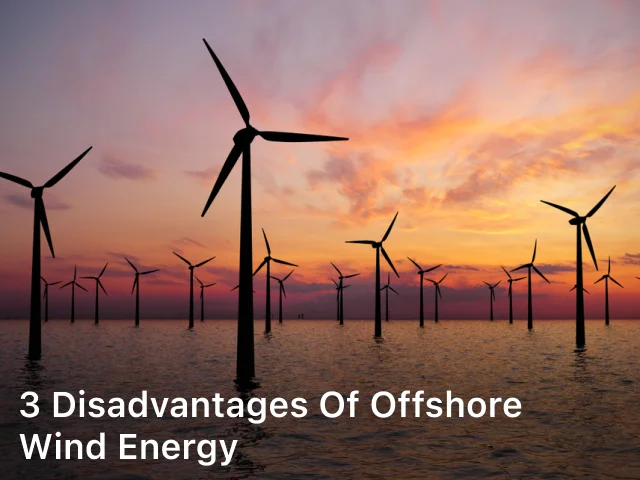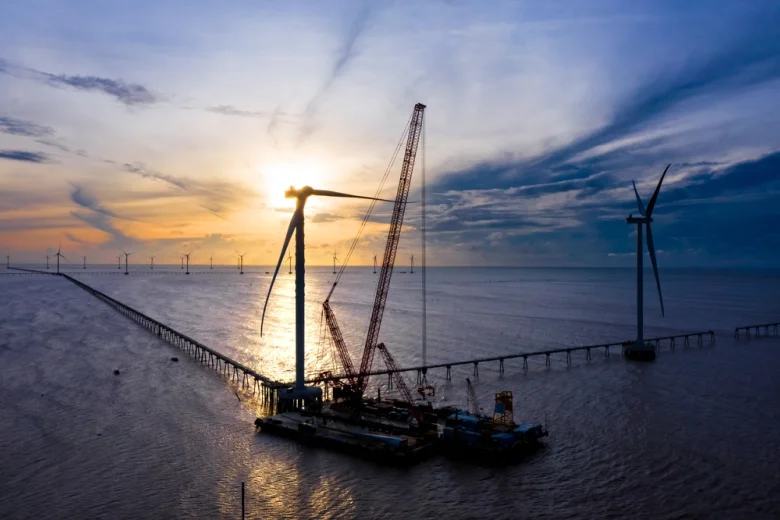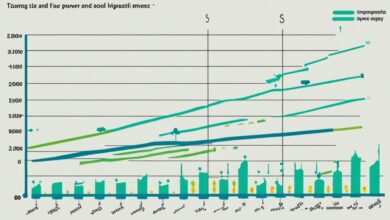
greentechinnovate.com. 3 Disadvantages of Offshore Wind Energy – Explore the 3 disadvantages of offshore wind energy and their impact on the renewable energy landscape. Learn about environmental concerns, maintenance challenges, and more in this in-depth article.
Offshore wind energy is often hailed as a promising source of clean, renewable power, but like any technology, it comes with its own set of drawbacks. In this article, we’ll delve into the three main disadvantages of offshore wind energy, shedding light on the challenges that this industry faces. From environmental concerns to maintenance issues, we’ll explore the intricacies of harnessing wind energy from the open sea.
What is offshore Wind Energy?
Offshore wind energy is a renewable energy source that involves the generation of electricity from wind turbines placed in bodies of water, such as oceans or seas. These wind turbines, commonly referred to as offshore wind farms, are strategically located in areas with consistent and strong wind patterns. As the wind flows over the surface of the water, it turns the blades of these turbines, which then convert the kinetic energy of the wind into electrical power.

Disadvantages of Offshore Wind Energy
Environmental Impact
Offshore wind energy is not without its environmental consequences, and it’s imperative to explore these challenges as the world shifts toward cleaner energy sources. The environmental impact of offshore wind energy primarily revolves around its interaction with the marine ecosystem. Here, we’ll delve deeper into these issues:
Impact on Marine Ecosystems
Noise Pollution: The operation of offshore wind turbines generates underwater noise, primarily during installation and maintenance. This noise can disrupt marine life, particularly creatures that rely on sound for communication and navigation.
For marine animals like whales and dolphins, this disturbance can lead to disorientation and increased stress levels. Researchers are actively studying ways to minimize these acoustic disturbances, such as using quieter installation methods and designing turbines with reduced noise emissions.
Physical Barriers: The construction and presence of offshore wind farms create physical barriers in the water. These structures can alter the movement patterns of marine species and impact their migration routes.
Fish, in particular, may be affected as they navigate around these massive turbines. Studies are ongoing to understand these effects better and develop strategies to mitigate these disruptions, including habitat mapping and proper placement of wind farms.
Electromagnetic Fields (EMF): Offshore wind farms generate electromagnetic fields through the operation of subsea power cables. These fields can impact the behavior of certain marine organisms that are sensitive to electromagnetic cues, such as some species of sharks and rays. Researchers are exploring strategies to minimize EMF emissions and protect these species while maintaining the efficiency of energy transmission.
Aesthetic Concerns
The aesthetic impact of offshore wind farms is a subjective issue that draws varying opinions. Some people find the sight of wind turbines at sea to be visually intrusive, impacting the natural beauty of coastal landscapes. This concern is particularly significant in areas known for their scenic coastlines, where residents and tourists value unobstructed ocean views.
To address this issue, offshore wind projects often consider aesthetic aspects in their design and planning phases. This includes the choice of turbine designs, their color schemes, and their distance from the shoreline. Efforts are also made to consult with local communities and stakeholders to find a balance between clean energy production and landscape preservation.
The environmental impact of offshore wind energy is a complex issue that demands a delicate balance between the benefits of renewable energy and the preservation of marine ecosystems and coastal aesthetics.
Ongoing research and technological innovations aim to minimize these disadvantages, ensuring that offshore wind energy can continue to contribute to a more sustainable future without unduly harming the environment.
Keep Reading : Why is Wind Energy Considered a Renewable Resource?
Maintenance Challenges
Offshore wind energy systems are a marvel of engineering, harnessing the power of the wind in the vast expanse of the open sea. However, their remote location and exposure to harsh weather conditions present a unique set of challenges when it comes to maintenance. Let’s delve deeper into these maintenance challenges:
Harsh Operating Conditions
Remote Locations: Offshore wind turbines are typically situated in remote areas, far from the coastline. This isolation poses logistical challenges for maintenance crews. They must travel long distances by boat or helicopter to reach the turbines, which can be time-consuming and costly.
Extreme Weather: The open sea is known for its unpredictable and often severe weather conditions. Maintenance activities become highly challenging and even dangerous during storms or adverse weather. Wind, waves, and saltwater can all take a toll on the turbines and equipment.
Corrosion and Wear: The constant exposure to saltwater and strong winds accelerates wear and tear on the equipment. Corrosion is a significant concern, affecting the structural integrity of the turbines. Maintenance teams must perform frequent inspections and repairs to ensure the safety and efficiency of the installations.
Cost of Maintenance
High Operational Costs: Offshore wind turbines require regular inspections, maintenance, and repairs to keep them operational. The cost of employing skilled personnel and maintaining specialized vessels and equipment can be substantial. These high operational costs are a key consideration for investors in offshore wind projects.
Subsea Maintenance: The underwater components of offshore wind turbines, such as foundations and cables, are particularly challenging to maintain. Specialized divers and remotely operated vehicles (ROV) are often required for these tasks, further increasing maintenance expenses.
Downtime: During maintenance and repair activities, turbines may need to be taken offline, resulting in a temporary reduction in energy production. The longer the downtime, the more revenue is lost. Therefore, maintenance must be carried out efficiently to minimize disruptions.
Addressing these Maintenance Challenges
To address the maintenance challenges associated with offshore wind energy, ongoing research and technological advancements are being pursued. Some key strategies include:
Predictive Maintenance: Utilizing data from sensors and monitoring systems to predict maintenance needs, thus reducing downtime and costs.
Advanced Coatings and Materials: Developing corrosion-resistant materials and coatings to extend the lifespan of offshore equipment.
Improved Access and Infrastructure: Investing in better infrastructure, such as crew transfer vessels and access platforms, to facilitate safer and more efficient maintenance operations.
Robotic Solutions: Developing robotic systems and autonomous drones to perform inspections and minor repairs in challenging conditions.
Standardization and Training: Standardizing maintenance procedures and investing in training for maintenance personnel to ensure safety and efficiency.
While offshore wind energy has immense potential as a renewable energy source, the challenges associated with maintenance should not be underestimated. Innovative solutions and ongoing research are vital to overcoming these challenges, ensuring the continued growth and sustainability of offshore wind energy in the global energy landscape.
Economic Considerations
The economic aspects of offshore wind energy play a pivotal role in determining its feasibility and widespread adoption as a clean energy source. While offshore wind farms offer numerous benefits, they are associated with unique economic challenges. Let’s delve deeper into the economic considerations surrounding offshore wind energy:
Initial Investment
High Upfront Costs: One of the most significant disadvantages of offshore wind energy is the substantial upfront investment required for project development. Building offshore wind farms is capital-intensive due to the need for specialized infrastructure, such as the installation of underwater foundations, transmission cables, and turbine towers. These costs often deter potential investors and project developers.
Return on Investment (ROI): The extended time required to recoup the initial capital investment poses a financial challenge. Investors typically expect a reasonable ROI over the long term, which can be uncertain in the early stages of offshore wind farm operation.
Government Support: To mitigate these high initial costs, many countries offer government incentives, subsidies, and grants to promote offshore wind energy development. These financial incentives aim to attract private investment and drive the growth of the industry.
Energy Transmission
Distance to Shore: Offshore wind farms are, by definition, situated at a considerable distance from the shoreline. Transmitting energy generated at sea to the onshore electrical grid involves additional expenses. Longer submarine cables are needed, and energy losses during transmission can be higher.
Grid Integration: Integrating offshore wind energy into the existing electrical grid infrastructure can also be challenging and expensive. Upgrades may be necessary to accommodate the intermittent and variable nature of wind power.
Maintenance Costs: As discussed in the “Maintenance Challenges” section, the maintenance of underwater components like cables is costly. These costs add to the economic considerations and affect the overall viability of offshore wind projects.
Addressing these Economic Considerations
To make offshore wind energy more economically viable, several strategies and initiatives are being pursued:
Technological Advancements: Developing more efficient and cost-effective wind turbine designs, as well as innovative installation and maintenance techniques, can help reduce the initial capital investment and ongoing operational costs.
Scaling Up: Expanding the scale of offshore wind projects can lead to economies of scale, making each unit of electricity generated more cost-effective. Larger projects can also attract more significant private and public investments.
Grid Improvements: Upgrading the electrical grid infrastructure to accommodate offshore wind energy can reduce transmission losses and improve grid stability.
Public-Private Partnerships: Collaborations between governments, private investors, and industry stakeholders can help share the financial burden and reduce the risk associated with offshore wind projects.
Policy Support: Governments can continue to provide financial incentives, tax credits, and long-term power purchase agreements to encourage investment in offshore wind energy.
While the economic considerations of offshore wind energy present challenges, concerted efforts in research, development, and policy support are steadily driving down costs and making this renewable energy source more competitive with traditional fossil fuels.
With ongoing innovation and strategic investments, offshore wind energy can play a significant role in reducing carbon emissions and meeting the growing global demand for clean electricity.
FAQs
Do offshore wind farms harm marine life?
Offshore wind farms can disrupt marine ecosystems, but mitigation measures are being explored to reduce their impact.
How do offshore wind turbines affect the environment visually?
Aesthetic concerns vary, but some people find the presence of wind turbines at sea unattractive, impacting the coastal landscape.
Are offshore wind turbines expensive to maintain?
Yes, maintenance of offshore wind turbines is costly due to their remote locations and harsh operating conditions.
Conclusion
While offshore wind energy offers a promising avenue for clean, renewable power, it’s essential to acknowledge and address its disadvantages. Environmental impacts, maintenance challenges, and economic considerations all play a role in shaping the future of this technology. By recognizing these drawbacks and actively working to mitigate them, we can continue to harness the potential of offshore wind energy while ensuring a sustainable and responsible energy future.




